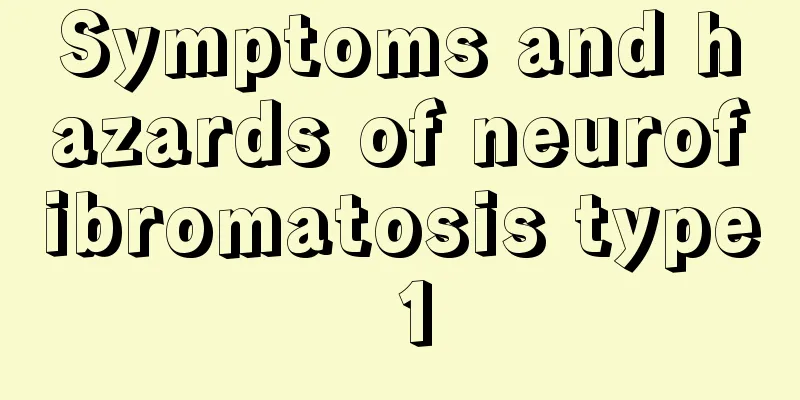Symptoms and hazards of neurofibromatosis type 1

|
Neurofibromatosis type 1 (NF1) is a relatively common genetic disease. Its typical symptoms include café-au-lait spots, skin fibromas and optic nerve gliomas, which may cause damage to nerves, skin and other organs. In severe cases, it can affect the quality of life and life expectancy. It is very important to seek medical treatment in time and take targeted treatment or intervention. 1Main symptoms The most common symptom of NF1 is the appearance of “café au lait spots” on the skin, which are light brown spots of varying sizes and irregular shapes. People may also notice small, soft, raised bumps on the skin, which are cutaneous neurofibromas, and their number may increase with age. Other possible symptoms include freckle-like spots in the armpits or groin, vision loss from optic nerve gliomas, and bone abnormalities such as scoliosis or osteodysplasia. Some patients may experience neurological manifestations such as learning difficulties, attention deficit and mood disorders, as well as local tenderness, itching or aesthetic effects of the tumor on the body surface. 2 Hazard Analysis The extent of harm caused by neurofibromas varies depending on the patient's condition. Mild symptoms may only affect aesthetics and mental health, while severe conditions may pose a greater threat to physical health. Local nerve damage: Neurofibromas under the skin may compress surrounding nerve tissue, causing pain, numbness, or dysfunction. Risk of tumor malignancy: Although most NF1-related fibromas are benign, some patients may be at risk of malignant peripheral nerve sheath tumors and require regular follow-up screening. Systemic impact: Optic nerve gliomas may cause blindness; bone deformities may limit the ability to take care of oneself; severe internal neurofibromas may even affect the function of important organs such as heart and lung function. 3 Treatment and management Although there is currently no cure for NF1, early diagnosis and standardized management can effectively alleviate symptoms and harm and improve the patient's quality of life. Common intervention measures include: Drug treatment: Mitotane and certain targeted drugs such as MEK inhibitors have the potential to control the growth of certain fibroids, but they must be taken under the supervision of a doctor. Surgical treatment: For skin fibromas that are significantly enlarged, internal tumors that compress important organs, or tumors that show signs of malignancy, timely surgical removal should be performed to relieve symptoms. Rehabilitation and psychological support: Regular physical examinations, imaging tests, and rehabilitation treatments for individual symptoms are also important, and patients may need psychological counseling to cope with the impact of the disease on their emotions and life. Neurofibromatosis type 1 affects not only appearance, but may also endanger the health of multiple systems. In order to clarify the condition and reduce the harm of the disease, patients need to visit the doctor regularly to monitor symptoms, follow the doctor's advice and take appropriate treatment and management measures to improve the quality of life and avoid worsening of the disease. |
<<: What are the hazards and sequelae of skin soft fibroma
>>: Prostate cancer life expectancy
Recommend
What are the benefits and harms of shooting incense
For ordinary people, their knowledge about musk p...
What are the specific signs of bile duct cancer
The occurrence of bile duct cancer brings physica...
Is it okay to have a breakfast checkup?
Many units organize physical examinations for the...
Symptoms of arm ligament strain
In fact, many people often feel ligament sprains,...
Is it normal for my underwear to be clean and have no discharge?
There are often some secretions on the underwear ...
Where can I remove moisture by fumigating with moxa sticks
Moxibustion is a health-preserving method in trad...
What should I pay attention to when I have peribronchitis?
No matter what kind of disease people suffer from...
Fever at this time is most likely to be cancer
Lymphoma most commonly occurs in the neck. Genera...
How to relieve brain fatigue
In our daily lives, we always feel physically tir...
What are the most typical characteristics of fibroids?
What are the most typical characteristics of fibr...
What should I do if I have osteosarcoma
Osteosarcoma is a serious malignant tumor of the ...
Pathological concept of special gastric cancer
The pathological concepts of special gastric canc...
Can a wife get pregnant if her husband has liver cancer
Liver cancer itself is not contagious and is not ...
What should I do if I have difficulty breathing, chest tightness, and abdominal distension?
Difficulty breathing, chest tightness and abdomin...
How to cure periodontitis?
The periodontium is a supporting tissue for the t...









